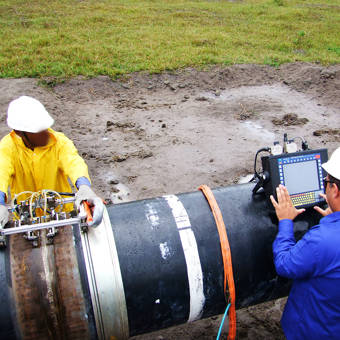Comprehensive Summary of Pipeline Welding Inspection Procedures
In the world of pipeline construction, guaranteeing the stability and safety of bonded joints is vital. Pipe welding assessment procedures play an important role in ensuring that bonded connections meet stringent market standards and requirements. From meticulous pre-welding examinations to extensive post-weld assessments, a well-defined inspection procedure is crucial for keeping the architectural stability of pipes. Recognizing the details of welding evaluation procedures is not only a governing requirement but additionally a fundamental aspect of supporting the reliability of these vital infrastructures.
Pre-welding Examination Preparations
Prior to starting the welding process, complete pre-welding assessment preparations are important to make sure the integrity and high quality of the weld joint. These prep work include a careful examination of the materials to be bonded, the welding devices, and the work setting. By carrying out complete pre-welding examination prep work, possible problems can be identified and settled early on, leading to reliable and high-grade weld joints.
Welding Treatment Credentials
Complete pre-welding examination prep work lay the structure for the critical procedure of Welding Procedure Qualification, guaranteeing the integrity and top quality of the weld joint. Welding Treatment Credentials (WPQ) is an important action in the welding process that involves screening and certifying welding treatments to ensure they fulfill certain standards and requirements. The WPQ process normally includes welding procedure spec development, welding procedure qualification testing, and documentation of the outcomes.
Throughout welding treatment spec advancement, necessary information such as the welding procedure, welding materials, joint layout, and welding parameters are specified to create a detailed treatment. Consequently, welding treatment certification screening is conducted to verify the recommended procedure's stability. This screening typically includes welding test discount coupons that go through different mechanical and non-destructive examinations to evaluate the weld's top quality and adherence to the defined standards.
In-process Weld Assessment
During the welding procedure, in-process weld assessment plays a critical function in ensuring the top quality and honesty of the weld joint - Pipeline Welding Inspection. This kind of inspection entails monitoring the welding criteria, examining the weld bead development, and identifying any possible problems or suspensions as they happen. By conducting in-process weld assessments, welding drivers can promptly address any kind of problems that may emerge, thereby ensuring and stopping additional flaws that the final weld fulfills the required specifications
Typical techniques utilized for in-process weld evaluation include visual assessment, fluid penetrant screening, magnetic bit testing, ultrasonic testing, and radiographic testing. Generally, in-process weld evaluation is vital for preserving the top quality and integrity of welded pipes.
Non-destructive Screening (NDT)
Non-destructive Testing (NDT) is a vital approach employed in pipeline welding evaluation to evaluate the stability of weld joints without creating damages to the welded framework. By making use of numerous NDT strategies, inspectors can assess the top quality of welds and recognize any defects or gaps that might compromise the structural stability of the pipeline. Usual NDT techniques utilized in pipeline welding evaluation consist of Radiographic Screening (RT), Ultrasonic Testing (UT), Magnetic Bit Checking (MPT), Fluid Penetrant Testing (LPT), and official website Visual Screening (VT)
RT involves the use of X-rays or gamma rays to create images of the internal structure of the weld, permitting assessors to find issues such as porosity, splits, or incomplete fusion. Additionally, VT entails visual assessment of welds to identify any type of visible imperfections.
Post-weld Assessment and Documentation


Paperwork of post-weld inspection searchings for is essential for preserving high quality control documents and guaranteeing conformity with industry standards and regulations. Detailed reports ought to consist of details regarding the inspection methods made use of, the location and nature of any type of issues found, and any rehabilitative activities taken - Pipeline Welding Inspection. Appropriate documentation not only acts as a document of the weld's top quality however likewise aids in future maintenance and examination procedures
Final Thought

Finally, pipe welding evaluation procedures play a vital role in making certain the high quality and honesty of welds. From pre-welding inspections to post-weld paperwork, each step is essential in keeping the safety and efficiency of pipes. he said By following well established treatments and performing complete inspections, possible issues can be recognized and dealt with before they lead to costly fixings or failings. Overall, adherence to proper examination protocols is key to the success of pipe welding jobs.
From precise pre-welding evaluations to thorough post-weld evaluations, a well-defined assessment process is necessary for keeping the structural strength of pipelines. By conducting in-process weld assessments, welding drivers can quickly resolve any kind of issues that may emerge, thus stopping more defects and making certain that the final weld satisfies the required specs.
Typical techniques used for in-process weld assessment consist of aesthetic assessment, liquid penetrant testing, magnetic fragment screening, ultrasonic screening, and radiographic screening.Non-destructive Screening (NDT) is a crucial method used in pipeline welding inspection to assess the stability of weld joints without causing damage to the bonded framework. Post-weld assessment involves numerous techniques to assess the welds for flaws, consisting of aesthetic evaluation, color penetrant testing, magnetic particle testing, ultrasonic screening, and radiographic screening.